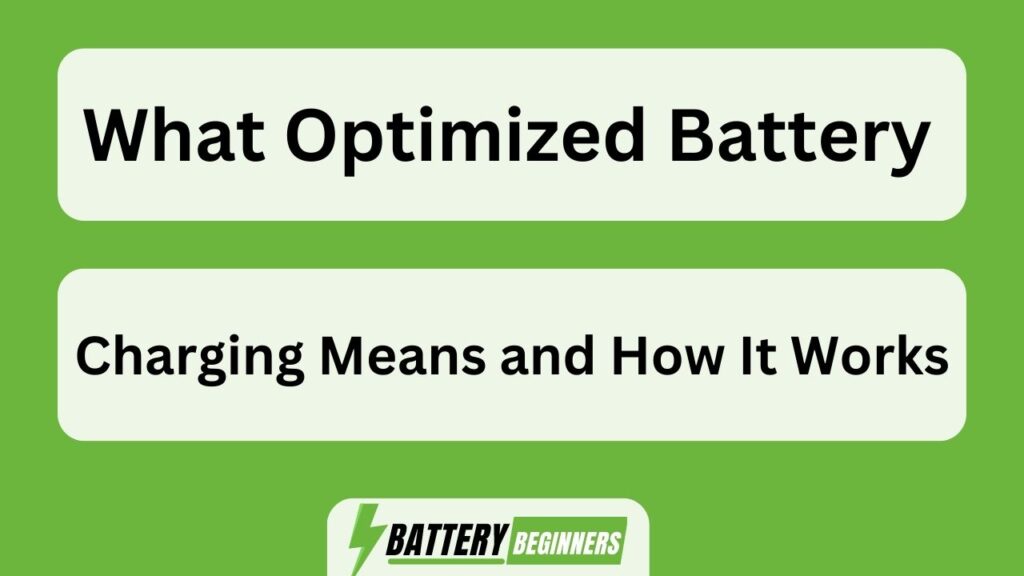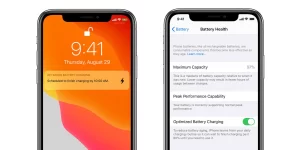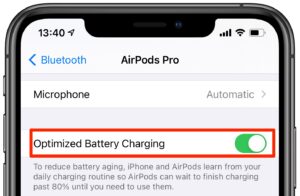‘Don’t waste your energy, let optimized battery charging do the work.’
This adage perfectly encapsulates the essence of optimized battery charging, a technological advancement that has revolutionized the way we recharge our devices.
In today’s fast-paced world, where smartphones and other portable devices have become an integral part of our lives, ensuring long-lasting battery life is crucial.
Optimized battery charging offers a solution by intelligently managing the charging process to extend battery longevity and enhance overall performance.
To understand how it works, one must delve into the realm of battery chemistry and explore the intricacies of lithium-ion batteries.
By employing sophisticated algorithms and machine learning techniques, optimized battery charging adapts to individual usage patterns and optimizes charge levels accordingly.
This article aims to shed light on this innovative technology, its benefits, compatibility with various devices, tips for maximizing battery life, dispelling common misconceptions about charging habits, as well as future developments in battery technology.
Key Takeaways of What Optimized Battery Charging Means And How It Works
- Optimized battery charging extends battery life and enhances performance.
- It intelligently manages charging based on usage patterns to minimize stress on cells and prevent degradation.
- Maintaining consistent voltage levels maximizes capacity and performance.
- Customizable settings analyze usage patterns and delay full charges, prolonging battery lifespan.
The Importance of Battery Optimization
The importance of battery optimization lies in its ability to prolong the lifespan of batteries and improve their overall performance.
Battery performance refers to how efficiently a battery delivers power over time, while battery health refers to the condition and capacity of a battery.
By optimizing the charging process, batteries can be charged in a way that minimizes stress on the cells, reducing the risk of degradation and extending their useful life.
Optimized charging algorithms ensure that batteries are not overcharged or undercharged, preventing damage caused by excessive heat or low voltage levels.
Additionally, optimized charging helps maintain consistent voltage levels throughout the charge cycle, which is crucial for maximizing battery capacity and ensuring reliable performance.
Understanding battery chemistry is essential for implementing effective optimization strategies without compromising safety or efficiency.
Understanding Battery Chemistry
Battery chemistry can be compared to a complex tapestry of interwoven chemical reactions, each thread playing a crucial role in the overall performance and longevity of the battery. Understanding battery chemistry is essential when it comes to optimizing battery charging techniques and increasing battery lifespan.
- Electrolytes: These are the conductive solutions within batteries that allow ions to flow between electrodes during charging and discharging.
- Cathode Materials: The choice of cathode material affects the energy density and voltage of the battery, which directly impacts its performance.
- Anode Materials: Similar to cathode materials, anode materials also influence the energy density and voltage, as well as the stability of the battery.
By understanding these aspects of battery chemistry, manufacturers can develop optimized battery charging techniques that take into account specific chemical reactions occurring within batteries. These techniques aim to prolong battery lifespan by minimizing stress on certain components while maximizing energy storage capacity.
How Optimized Battery Charging Works
An effective strategy for enhancing the performance and longevity of batteries involves understanding the intricate mechanisms behind how charging techniques can be optimized. Battery charging techniques play a crucial role in maintaining battery health and ensuring that it operates at its optimum capacity.
Optimized battery charging involves carefully monitoring and controlling the flow of current to the battery, taking into account factors such as temperature, voltage, and state of charge. By employing sophisticated algorithms and advanced circuitry, optimized charging ensures that the battery receives the right amount of charge without overcharging or undercharging it. This not only maximizes the battery’s lifespan but also improves its overall performance.
Understanding these techniques is essential for developing efficient charging systems that benefit various applications across industries. Transitioning into the subsequent section about ‘benefits of optimized battery charging,’ it becomes evident that this approach offers numerous advantages for both consumers and manufacturers alike.
Benefits of Optimized Battery Charging
By unlocking the secrets of a well-tuned symphony, optimized battery charging orchestrates a harmonious dance between current flow and battery health, delivering an enchanting performance that extends longevity and elevates performance.
One of the key benefits of optimized battery charging is maximizing efficiency. This intelligent system ensures that the battery is charged at the optimal rate, avoiding overcharging or undercharging which can lead to energy wastage. By efficiently utilizing the available power supply, optimized battery charging minimizes energy loss and maximizes overall efficiency.
Another significant advantage of this technology is its ability to extend the lifespan of the battery. Traditional charging methods often expose batteries to prolonged periods of high voltage or excessive heat, which can degrade their capacity over time. Optimized battery charging mitigates these issues by carefully monitoring and controlling the charging process, preventing damage caused by overcharging or overheating.
Transitioning into the subsequent section about compatibility with different devices, optimized battery charging provides a versatile solution for various gadgets while ensuring efficient power management.
Compatibility with Different Devices
Compatibility with various devices is a key aspect of optimized battery charging, as it offers an adaptable solution that effectively manages power for different gadgets. This feature ensures that the charging process is compatible with a wide range of devices, including smartphones, tablets, smartwatches, and even wireless charging pads.
1) Wireless charging: Optimized battery charging is designed to work seamlessly with wireless charging technology. It intelligently adjusts the power flow to ensure efficient and safe charging without overheating or damaging the device.
2) Charging speed: Another important factor in compatibility is the ability to adjust the charging speed according to the device’s requirements. Optimized battery charging optimizes the power flow based on the specific device’s capabilities, allowing for faster or slower charging as needed.
3) Device recognition: Compatibility also involves recognizing different devices and their unique power needs. Optimized battery charging can identify and adapt to various devices by analyzing their battery capacity and adjusting the charge rate accordingly.
By ensuring compatibility with different devices, optimized battery charging provides an efficient and tailored charging experience. This seamless transition between various gadgets leads us into discussing how users can adjust settings for optimized battery charging.
Adjusting Settings for Optimized Battery Charging
In addition to its compatibility with different devices, optimized battery charging also provides the option of adjusting settings to further enhance battery performance. By allowing users to customize their charging preferences, this feature ensures that the battery is not overcharged or exposed to prolonged high temperatures, which can degrade its overall capacity.
Users can access the settings menu on their devices and enable optimized battery charging, which automatically learns their daily charging patterns and adapts accordingly. This involves analyzing usage patterns and intelligently delaying full charges until a user’s typical wake-up time. By doing so, it reduces the amount of time a device spends fully charged, thereby minimizing stress on the battery and prolonging its lifespan.
These customizable settings for optimized battery charging pave the way for maximizing battery life while ensuring optimal performance.
Transitioning into the subsequent section about ‘tips for maximizing battery life’, it is important to consider other factors that contribute to overall battery longevity.
Tips for Maximizing Battery Life
To maximize the lifespan of a device’s battery, it is essential to implement effective strategies that promote efficient energy usage. Maximizing battery performance and extending battery lifespan can be achieved by following these tips:
- Avoid overcharging: Overcharging can lead to excessive heat generation and damage the battery. It is advisable to unplug the device once it reaches full charge.
- Optimize screen brightness: High screen brightness consumes significant amounts of power. Adjusting the screen brightness level to a lower setting can help conserve battery life.
- Disable unnecessary features and apps: Background processes, push notifications, and unused apps consume valuable battery power. Disabling or closing these features when not in use can extend the device’s battery life.
By implementing these strategies, users can effectively maximize their device’s battery performance and extend its overall lifespan.
This leads us into the subsequent section about common misconceptions about battery charging.
Common Misconceptions about Battery Charging
This paragraph will discuss two common misconceptions about battery charging: overcharging and memory effect.
Overcharging refers to the belief that leaving a battery plugged in for an extended period of time damages its ability to hold a charge. However, modern smartphones and electronic devices are designed with built-in mechanisms to prevent overcharging, making this misconception largely irrelevant.
The memory effect misconception suggests that regularly discharging a battery completely before recharging it helps maintain its capacity. However, this is not applicable to most modern rechargeable batteries, as they use different technology that eliminates the memory effect.
Overcharging
Overcharging, a common issue in battery charging, can lead to reduced battery life and potential safety hazards. Battery maintenance is crucial to ensure optimal performance and longevity.
When a battery is overcharged, it continues to receive an excessive amount of current beyond its capacity. This causes the battery to heat up, which accelerates chemical reactions within the cells and leads to degradation of the electrolyte solution. Moreover, overcharging can cause the release of hydrogen gas, increasing the risk of explosion or fire.
To prevent overcharging and maximize charging efficiency, modern chargers are equipped with advanced technologies such as voltage regulation and charge termination mechanisms. These features help monitor the battery’s state and adjust charging parameters accordingly.
Understanding overcharging is essential in addressing this issue effectively before delving into other aspects like memory effect that affect battery performance.
Memory Effect
Memory effect, also known as battery memory, is a phenomenon that can significantly impact the performance and overall lifespan of rechargeable batteries. It occurs when a battery is repeatedly charged after being only partially discharged, resulting in a reduced capacity to hold a charge over time. This effect was initially observed in nickel-cadmium (NiCd) batteries but is less prevalent in modern lithium-ion batteries.
To understand memory effect better, it is helpful to consider the concept of charging cycles. A charging cycle refers to the process of discharging a battery and then fully recharging it. Each time a partial discharge occurs followed by recharging, the battery’s capacity becomes slightly lower than its original maximum capacity. Over time, this reduction accumulates and leads to diminished performance and shorter overall lifespan.
In order to mitigate memory effect and maximize battery maintenance, it is recommended to avoid partial discharges whenever possible. Instead, allowing for full discharges followed by complete recharges helps prevent the build-up of memory effect and maintains optimal battery performance.
Future developments in battery technology aim to address issues such as memory effect by improving the design and materials used in rechargeable batteries. These advancements will likely result in longer-lasting batteries with enhanced efficiency and reduced susceptibility to memory effects or other degradation factors without compromising their power output or safety features.
Future Developments in Battery Technology
In the realm of battery technology, future developments are focused on advancing materials and fast charging solutions.
Advanced materials play a crucial role in enhancing battery performance by improving energy density, cycle life, and safety. Researchers are exploring innovative materials such as solid-state electrolytes and lithium-air batteries to achieve higher energy storage capabilities.
Additionally, fast charging solutions are being developed to address the need for rapid recharging without compromising battery longevity, utilizing technologies like high-power chargers and advanced algorithms for efficient power transfer.
Advanced Materials
Advanced materials play a crucial role in optimizing battery charging by enhancing the efficiency and stability of the charging process. These advanced materials are designed to improve various aspects of battery performance, such as energy density, power output, and cycle life.
For example, researchers have been exploring new electrode materials with higher specific capacities and improved conductivity to enable faster charging rates. Additionally, advanced electrolyte materials with enhanced ion conductivity and stability are being developed to minimize energy loss during charging.
Furthermore, the use of advanced materials in battery manufacturing can also contribute to reducing costs and environmental impact. By incorporating these innovative materials into battery design, manufacturers can achieve more efficient and reliable charging processes.
This focus on advanced materials paves the way for the subsequent section on fast charging solutions without compromising battery performance or safety.
Fast Charging Solutions
Efficient and reliable fast charging solutions are imperative for meeting the growing demand for quick and convenient battery recharging, thereby enhancing user experience and satisfaction. Fast charging techniques have been developed to significantly reduce charging times without compromising the battery’s lifespan.
These techniques involve increasing the charging current or voltage to deliver more power to the battery, allowing it to charge at a faster rate. However, it is important to consider the impact of fast charging on battery lifespan. Rapid charging can generate additional heat, which can accelerate chemical reactions within the battery and potentially lead to degradation over time.
To overcome this challenge, advanced materials and design optimizations are being implemented in fast-charging solutions to mitigate heat generation and ensure long-term battery health.
Transitioning into frequently asked questions about optimized battery charging: Understanding these considerations will help address common concerns regarding fast-charging technology’s effects on batteries.
Frequently Asked Questions about Optimized Battery Charging
One common inquiry regarding optimized battery charging pertains to frequently asked questions about this particular technology.
Optimized battery charging is a method of prolonging the lifespan of a battery by intelligently managing its charge level. This technique employs various strategies to minimize stress on the battery and prevent overcharging, which can lead to degradation over time.
By analyzing usage patterns and understanding user behavior, optimized battery charging adjusts the charging rate and duration accordingly. For instance, it may slow down charging when the battery reaches a certain level or delay charging until it predicts that the device will be needed again.
These techniques aim to reduce unnecessary charge cycles and keep the battery within an optimal voltage range, ultimately extending its overall lifespan.
Frequently Asked Questions
How long does it take for the battery optimization process to complete?
The battery optimization process duration varies depending on several factors, such as the device’s battery capacity and current charge level. This process aims to enhance battery health by intelligently managing charging patterns, which can extend its overall lifespan.
Does optimized battery charging work with all types of batteries?
Optimized battery charging offers benefits and limitations. While it can enhance the lifespan of lithium-ion batteries by avoiding overcharging, it may not be compatible with all types of batteries due to their varying characteristics and requirements.
Can I use my device while it is undergoing optimized battery charging?
Using a device during optimized battery charging can have an impact on battery performance. It is advisable to avoid using the device while it is undergoing this process to ensure optimal charging and prolong the lifespan of the battery.
Will optimized battery charging affect the overall lifespan of my device’s battery?
Optimized battery charging can positively impact the overall lifespan of a device’s battery. By intelligently managing the charging process, it minimizes stress on the battery and reduces wear and tear, resulting in extended battery longevity.
Is there a way to disable optimized battery charging if I don’t want to use it?
Disabling optimized battery charging may have potential drawbacks such as reduced battery lifespan and decreased overall performance. Alternatives for extending battery lifespan include manual charging management and using power-saving modes.
Conclusion
In conclusion, optimized battery charging is a crucial aspect of maximizing the performance and lifespan of batteries. By understanding the intricacies of battery chemistry, manufacturers have developed intelligent charging algorithms that adapt to individual device usage patterns.
This technology provides numerous benefits such as improved battery health, reduced energy consumption, and enhanced user experience. Despite common misconceptions surrounding battery charging practices, optimizing the way we charge our devices is essential for long-term sustainability.
As future advancements in battery technology continue to emerge, we can look forward to even more efficient and eco-friendly solutions in the years to come.






